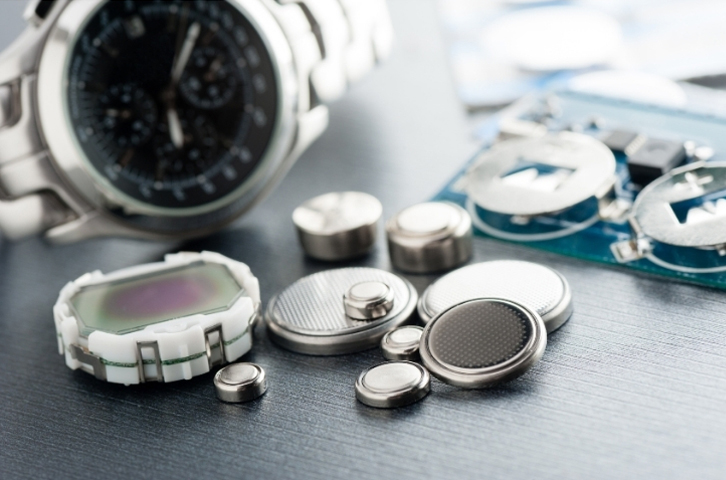Nurse’s Review: Button Batteries Pose Risk to Kids
A review of studies on the pediatric risks around button batteries finds both cause for concern and tips to reduce the chance of an emergency.

Button batteries are a part of everyday life, found in thousands of appliances and household items like remote controls, toys, and greetings cards. However, their shiny appearance often attracts young children, leading to accidental ingestion. Duke School of Nursing’s Emily Funk, DNP, CRNA, recently published a review of literature in The Journal of PeriAnesthesia Nursing that investigated this little known, but unfortunately common, threat to pediatric health.
Funk’s article, Button Battery Ingestion in Children: An Educational Review for Perioperative Nursing, found that button battery ingestion poses a significant risk to children, particularly those under six years of age. As advances in technology have led to an increased number of household electronics on the market, the number of incidents where children accidently ingest these small batteries has increased dramatically. Funk notes that between 2010 and 2019, over 70,000 battery-related emergency room visits were recorded in the United States, with 85% of those visits involving button batteries. Children aged five and under are most at risk, with one-year-olds being the most affected.
“My son was in the high-risk age group for button battery ingestion when I learned of the death of 18-month-old Reese Hamsmith on national news one morning by a button battery ingestion that came from a TV remote control,” Funk recalled. “I looked at my own remote control in my hand and realized it contained a button battery and had no sophisticated mechanism to keep a child from sliding off the back and accessing the CR 2032 button battery.”
“He was of the age when everything goes into the mouth,” Funk continued. “As a nurse anesthetist in pediatrics, several cases also acutely presented in our clinical environment which really raised my awareness.”
When a button battery becomes lodged in the esophagus, it can create an electrical circuit, leading to severe tissue damage. The electrolysis reaction generates hydroxide ions, causing an alkaline environment that results in tissue necrosis within just 15 minutes. If not removed within two hours, the damage can extend to deeper tissues, potentially causing life-threatening complications, such as esophageal perforation and erosion into major blood vessels.
To further complicate things, diagnosing button battery ingestion can be challenging, especially if the incident is unwitnessed. Symptoms are often nonspecific, including irritability, vomiting, and drooling. A chest X-ray is a crucial diagnostic tool, revealing a distinctive double ring or “halo” sign that differentiates a button battery from a coin.
Immediate removal of the battery is essential to prevent severe complications. Delays can lead to significant tissue damage and increase the risk of fatal outcomes.
Funk’s review found that there are some mitigation and prevention strategies that parents and those who care for young children can take to avoid such an emergency.
“Some of the most interesting studies cited in this review include the mitigation strategies to minimize risk – including the ingestion of honey,” Funk said. “Because the most significant tissue damage occurs due to the caustic alkaline environment created by the battery impaction, children may be encouraged to consume a slightly acidic substance to decrease the tissue pH at the side of the battery while efforts are made to arrange battery removal.” In the hospital, sucralfate suspension may be administered as an alternative.
But the key to keeping children safe is preventing the ingestion of these batteries in the first place. “Enacted in 2022, Reese’s Law (P.L. 117-171) now mandates federal safety requirements for button batteries,” Funk pointed out. “The requirements impact all domestic or imported consumer devices that use a button battery and include safety standards for performance, labeling, and certification. This was a big win, as not hard to believe if you’re a caregiver, children will get into anything, not just toys!”
Additionally, the U.S. Consumer Product Safety Commission has changed safety standards for all consumer products (toys included) that use a button battery. Funk notes, however, that there are many products on the market and in homes that were made before these safety measures were enacted.
“Button battery ingestion is potentially fatal in children (and also pets), and the number of ingestions and complications has unfortunately continued to increase,” said Funk. “The word needs to be spread about the dangers of button batteries. Toys bought at garage sales, hand-me-downs, garage door openers, fidget spinners, saved greeting cards - many items can be an unsuspecting source.”
For those who care for young children, Funk has a few practical points and pieces of advice:
- The ingestion of a button battery (known or suspected) is an emergency. An impacted button battery in the esophagus should be removed within 2 hours in order to minimize the risk of significant tissue damage and death.
- Children over the age of 12 months should consume honey when a button battery ingestion is witnessed or diagnosed, if less than 12 hours have elapsed.
- Call the Button Battery Ingestion Hotline at 1-800-498-8666 (24/7/365) to get immediate assistance: Battery Ingestion Hotline
